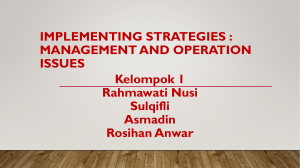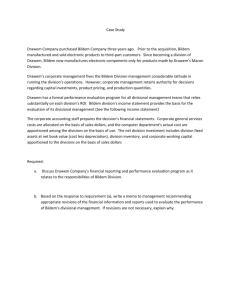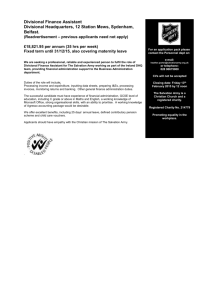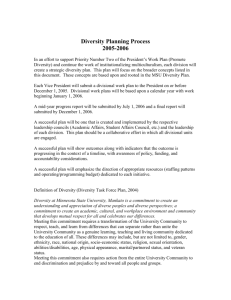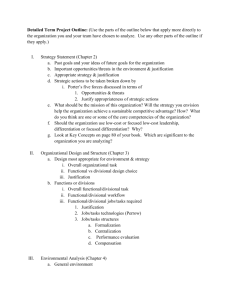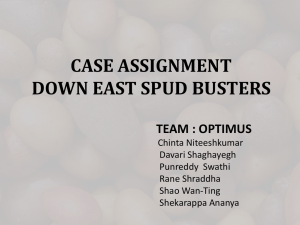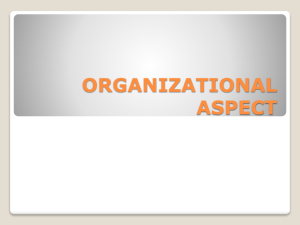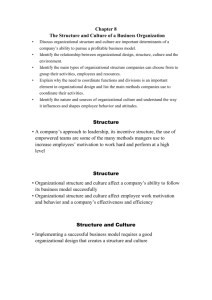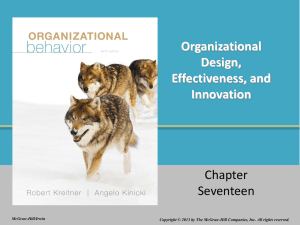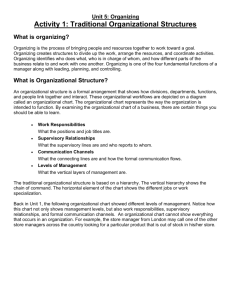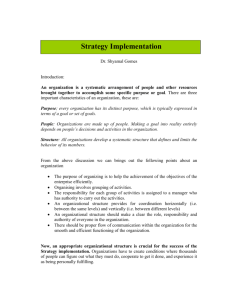Chapter 7 Implementing Strategies
advertisement
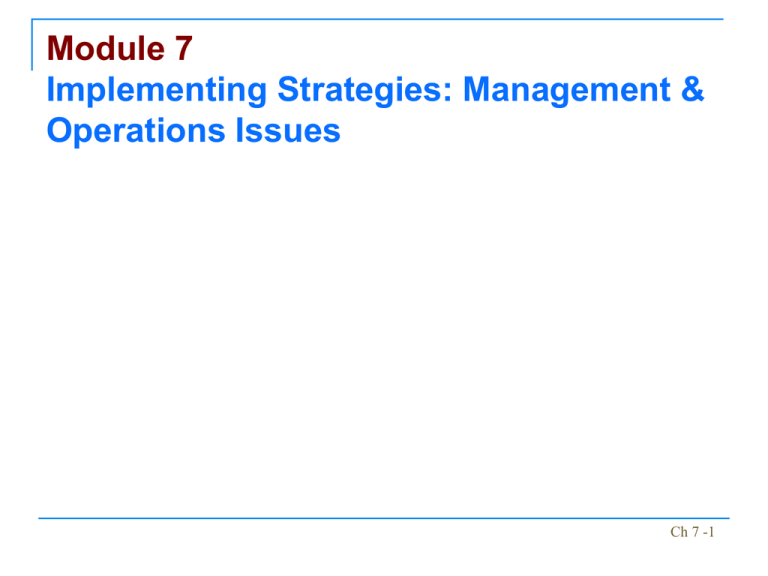
Module 7 Implementing Strategies: Management & Operations Issues Ch 7 -1 Ch 7 -2 Strategy Formulation vs. Implementation Strategy Formulation Positioning forces before the action Focus on effectiveness Primarily intellectual Requires good intuitive and analytical skills Requires coordination among a few people Strategy Implementation Managing forces during the action Focus on efficiency Primarily operational Requires special motivation and leadership skills Requires coordination among many people Ch 7 -3 Nature of Strategy Implementation Management Perspectives Shift in responsibility Strategists Divisional or Functional Managers Ch 7 -4 Management Issues Central to Strategy Implementation Establish annual objectives Devise policies Allocate resources Alter existing organizational structure Restructure & reengineer Revise reward & incentive plans Minimize resistance to change Match managers to strategy Develop a strategysupportive culture Adapt production/operations processes Develop an effective human resources function Downsize & furlough as needed Link performance & pay to strategies Ch 7 -5 Purpose of Annual Objectives Basis for resource allocation Mechanism for management evaluation Major instrument for monitoring progress toward achieving long-term objectives Establish priorities (organizational, divisional, and departmental) Ch 7 -6 Annual Objectives Horizontal consistency of objectives Vertical consistency of objectives Ch 7 -7 Policies Policies set boundaries, constraints, and limits on the kinds of administrative actions that can be taken to reward and sanction behavior Ch 7 -8 Resource Allocation Four Types of Resources 1. Financial resources 2. Physical resources 3. Human resources 4. Technological resources Ch 7 -9 Managing Conflict Conflict not always “bad” Lack of conflict may signal apathy Can energize opposing groups to action May help managers identify problems Ch 7 -10 Managing Conflict Approaches for managing and resolving conflict Avoidance Defusion Confrontation Ch 7 -11 Matching Structure with Strategy Structure dictates how objectives and policies will be established Structure dictates how resources will be allocated Changes in strategy often lead to changes in organizational structure Ch 7 -12 Ch 7 -13 Basic Forms of Structure Functional Structure Divisional Structure Strategic Business Unit Structure (SBU) Matrix Structure Ch 7 -14 Functional Structure Group tasks and activities by business function Ch 7 -15 Functional Structure Ch 7 -16 Divisional Structure Can be organized in one of four ways: By geographic area By product or service By customer By process Ch 7 -17 Divisional Structure Ch 7 -18 Strategic Business Unit Structure (SBU) Group similar divisions into strategic business units and delegate authority and responsibility for each unit to a senior executive who reports directly to the chief executive officer Ch 7 -19 Matrix Structure The most complex of all designs because it depends upon both vertical and horizontal flows of authority and communication Ch 7 -20 Matrix Structure Ch 7 -21 Restructuring, Reengineering, and E-engineering Restructuring is called Downsizing Rightsizing Delayering Ch 7 -22 Restructuring, Reengineering, and E-engineering Cornerstones of Reengineering Decentralization Reciprocal interdependence Information sharing Ch 7 -23 Tests for Performance-Pay Plans Does the plan capture attention? Do employees understand the plan? Is the plan improving communication? Does the plan pay out when it should? Is the company or unit performing better? Ch 7 -24 Managing Resistance to Change Force change strategy Educative change strategy Rational or self-interest change strategy Ch 7 -25 Creating a Strategy-Supportive Culture 1. 2. 3. 4. 5. Formal statements of organizational philosophy Design of physical spaces Deliberate role modeling, teaching, and coaching Explicit reward and status system Stories, legends, myths, and parables Ch 7 -26 Creating a Strategy-Supportive Culture 6. 7. 8. 9. 10. What leaders pay attention to Leader reactions to critical incidents and crises Organizational design and structure Organizational systems and procedures Criteria for recruitment, selection, promotion, leveling off, retirement, and “excommunication” of people Ch 7 -27 Production/Operations Concerns Production processes typically constitute more than 70% of a firm’s total assets Ch 7 -28 Production/Operations Decision Examples Plant size Inventory Quality Cost / Inventory control control control Technological innovation Ch 7 -29 Human Resource Concerns Assessing staffing needs/costs Furloughs Developing performance incentives ESOPs Work–life balance issues Matching managers with strategy Ch 7 -30 Corporate Wellness Programs Wellness of employees has become a strategic issue for many firms Ch 7 -31
